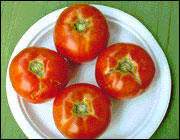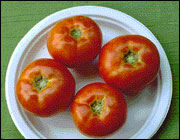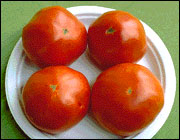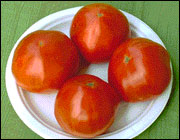Whether on an individual basis at fairs or in 4-H, FFA or a garden club competition, exhibiting vegetables is an excellent way to learn more about quality and handling of vegetables. While setting up an exhibit, you have a chance to meet others with similar interests and learn from them. Win or lose, you can learn from the experience and accept the challenge to improve future displays and exhibits.
Follow the rules
Rules and classes normally are set up by the show or fair committee. These rules should be followed carefully. Failure to set up or classify a display properly may mean automatic disqualification, even for the best vegetables.
Read premium lists carefully so that the correct number of specimens are exhibited in each class. There is no “correct” number of items for all events, and each committee is responsible for establishing its own requirements. The number of items required for any display, however, should be clearly listed in the fair catalog.
How many vegetables in a display?
When in charge of determining the number of vegetables to be required in each display, remember that normally the larger and heavier the product, the fewer specimens required. Therefore, large watermelons, muskmelons, pumpkins and winter squash are often shown as single specimens.
Vegetables of smaller size normally are shown in groups of three to six. Small pumpkins, eggplant and small winter squash may be shown in groups of three, while vegetables such as tomato, cucumber and pepper normally are shown in groups of four to six.
Root crops more often are shown in groups of eight to 12. Because crops such as potatoes, onions, carrots and beets are more variable in shape and development, a larger sample is necessary for a better evaluation.
For crops that are very productive and relatively uniform, an even larger sample is necessary. Therefore, such items as snap beans or cherry tomatoes are displayed in groups of 18 to 24.
Leafy vegetables, such as cabbage or lettuce, usually are shown as single heads, but when leaves are cut individually, such as for chard or rhubarb, about six to 12 stems should be in each display.
The contest rules should list the amount for each exhibit determined by the show or fair committee. If any changes are made, announcements should be made well in advance of display time so that participants are prepared to display the correct number of vegetables.
Some shows have displays called “collections” in which the exhibitor is allowed some choice in selecting and placing an assortment of vegetables. Quality and condition of the vegetables are important in these displays, but a pleasing arrangement and display is also considered in the judging.
Containers and materials
Two types of containers normally are used for a vegetable display. Plates are used most widely for displaying fruiting vegetables such as tomatoes, cucumbers or beans. Leafy vegetables such as lettuce or chard are displayed in jars containing water. Wide-mouth pint or quart canning jars usually are adequate, but the fair or show may specify other containers or even furnish containers. Large vegetables such as watermelons or pumpkins do not require a display container.
When paper plates are used, they should be simple and unadorned. The large, dinner plate size is preferred. Liners, pads, doilies and other flourishes are unnecessary and undesirable. The judge must make an objective evaluation of the vegetables, and extra items mean nothing and may actually annoy judges.
Plastic films may be used to protect vegetables during travel or set-up but should be removed before judging. Do not enclose moist vegetables in films during hot weather, as rapid decay might occur. A judge may understand slight wilting at the time of judging under hot conditions, but decay is inexcusable at any time.
Crop maturity
Because fairs and shows are held over a wide range of dates, having vegetables at the ideal stage of maturity at the time of a show may be difficult. Ideal maturity is desirable, however, and will win over immature or overmature products. Never exhibit overripe or overmature vegetables. In some seasons, only slightly immature crops may be available.
Rather than not participate, the beginning exhibitor could gain experience by showing slightly immature vegetables that are as perfect as possible. In large shows or fairs, however, where competition is keen, only enter the highest quality produce at proper maturity.
Preserving quality for the show
Many vegetable crops do not last long in the display, especially during hot weather. Timing a crop for proper maturity at the time of showing is important. Crops that apparently will mature ahead of display time should be picked just slightly immature and placed in good storage conditions until about a day or two before display time, when they may be allowed to mature for the show.
Crops that store well in a cool, dry place, such as a cool basement, include potatoes, onions, winter squash, watermelon, pumpkin, dry beans and Cushaw pumpkins (sometimes called crookneck squash).
Other crops require some refrigeration and/or moisture to keep them in good condition. Clean and refrigerate the vegetables immediately after harvest. Vegetables with a naturally waxy or corky skin may be refrigerated dry. These include pepper, cucumber and cantaloupe.
Many root crops and leafy vegetables should be stored in loose plastic bags or sprinkled daily with fresh water and kept in a refrigerator’s vegetable crisper. Such crops include green beans, carrots, beets, sweet corn, okra, cabbage and other leafy vegetables.
Moving vegetables to the show
Vegetables for display must be handled carefully. To prevent bruising during travel, they should be wrapped and padded in baskets or boxes. A lining or loose wrapping of plastic also can prevent drying. Protect them from the sun to prevent discoloration. Avoid light on potatoes, which can cause greening.
If vegetables have been stored cool and “sweat” when brought into a warm room, they should not be wrapped or placed in closed containers until they have warmed and moisture condensation has stopped. Wipe them dry before packing. Always take a few extra vegetables in case of damage or injury during handling and moving.
Factors considered in judging
When preparing a display for exhibit, knowing what judges will look for in the display is helpful. The judge may lift and examine products on all sides, so imperfections cannot be hidden (Figures 1 and 2). The important characteristics of good vegetables are not greatly different from those looked for in flowers and fruits.
Always show crops at their best. Some grooming is important, but grooming should not give an unnatural look to the crop. The main characteristics a judge evaluates in each exhibit are quality, condition, uniformity and typical of variety.
Quality
One of the most important but difficult to describe characteristics is quality. Quality means that the vegetable is at its best and in prime eating condition. Prime eating condition may be at a fairly young stage in some vegetables, such as summer squash, beets or green beans. It means fully developed fruits at the peak of maturity in others, such as tomato, watermelon or eggplant.
The inherent quality of a vegetable includes color, shape, texture, taste and size. Quality is also a measure of the ability of the person who has grown the vegetable for display.
Condition
Condition is a measure of how the crop has been handled. An important part of this evaluation is cleanliness. Such items as tomato or pepper are seldom a problem, but root crops such as onions, potatoes and beets, or leaf crops such as lettuce may present problems in cleaning. Do not wash vegetables for exhibit unless absolutely necessary. Instead, use a very soft cloth or brush, and lightly remove any soil. For some vegetables, washing may remove the waxy “bloom,” which should be left on. For others, washing gives an unnatural “scrubbed” appearance.
Vegetables also must be free of blemishes. Blemishes may be caused by insects, diseases or poor handling. Presence of such damage indicates poor care or culture and is a serious fault. Slight bruising or punctures caused by handling are undesirable but, if small, are not rated downward as much as damage by insects or diseases. Sun scald or hail damage are also undesirable.
Uniformity
One of the most obvious conditions of a display is uniformity (Figures 3 and 4). Uniformity of the products in a display is another measure of ability because of the difficulty of growing a large number of vegetables that look identical. The larger the planting, however, the more likely an exhibitor will be able to develop very uniform displays.
Size is an important aspect of uniformity. All vegetables in one exhibit should be the same size. In addition, the size should be typical of the variety — not too large or too small. Oversized vegetables do not receive extra points, and sometimes they may be at a disadvantage.
Uniform ripeness is also important. A display with slightly immature and uniform vegetables is better than one with items at different stages of maturity.
The vegetables should be uniform in shape. For example, do not mix round and flat onions; onions in a single display should be all the same shape. Select peppers, small pumpkins or eggplant of as identical shape as possible.
Uniform color is very evident and also important. A single off-color item in a display is a serious fault. Green peppers should be entirely green; one with a red splotch downgrades the display.
Typical of variety
All vegetables in the same exhibit should be the same kind and variety. Mixing types or varieties is usually an automatic disqualification. All entries should be typical of the variety. Some shows require that the variety be listed with the display. This practice is often helpful to the judge, especially in the case of very new or unusual varieties.
Automatic disqualifications
The judge will try to evaluate as many exhibits as possible. Failure to follow rules and to display properly may mean that your entry will not be judged. These conditions usually mean an automatic disqualification:
- Incorrect number for the class
- Improper preparation of the vegetables, such as excessive peeling of onions or greening on potatoes
- Mixture of types or varieties within a single display
Pointers for exhibiting vegetables
All exhibits should fulfill the qualifications described above. In addition, individual vegetables have some special considerations.
Asparagus
Select straight, dark green spears. They should be at least 1/2 inch diameter at the butt end and trimmed to a uniform length of 7 to 8 inches. Display in water to prevent wilting.
- Beans, snap
Either green or yellow, pole or bush. Beans on display should be whole with about 1/4 inch of stem. They should be cleaned and not contain any trash or spent blossoms. Pods should be plump and fleshy with small seeds from 1/4 to 1/8 inch in diameter. Pods should have the same degree of curvature and be arranged with the stems and curves facing the same way. - Beans, lima
Select full size, dark green pods that are still tender and fresh. Beans inside should be well developed. Do not use pods that have begun to yellow. Arrange neatly as described for snap beans. - Beans, dry
Unshelled dry beans are harvested, selected and displayed in the same fashion as fresh beans. They may not be washed, but trash will have to be removed by careful brushing. - Beets
Roots should be well colored, smooth, tender and well shaped according to variety. Select roots 1-1/2 to 2-1/2 inches in diameter. Allow most of tap root to remain. Trim tops 1 to 1-1/2 inches. - Broccoli
Select heads that are fresh, firm, tender, tight and crisp. Color should be dark green with a bluish cast. The minimum diameter of the head should be 3 inches with the stalk 6 to 8 inches long. Remove all leaves below the head. No yellow florets should be developed on the head. - Brussels sprouts
Sprouts should not be less than 1 inch in diameter. They should be round, fresh and firm. Stems should be smoothly trimmed to about 1/4 inch. - Cabbage
Heads should be firm, crisp and heavy for their size. They should not be trimmed excessively, but loose leaves should be removed, keeping the last two to three "wrapper" leaves that show the "field" color rather than the shaded undercolor. Cut the stem off squarely at the base of the outermost leaf. - Carrots
Select straight roots typical of the variety, free from cracks, knots and greening of the shoulders. Cut tops squarely about 1 inch long. Remove stumps of dead leaves. Wash free of soil carefully, but do not scrub. - Cauliflower
Select heads that are firm, crisp, white and free of graininess and roughness. The head should be 5 or more inches in diameter. The head should not be granular or ricey. Remove lower wrapper leaves. - Chinese cabbage
Heads should be thick, firm and crisp. Allow two to four outer leaves to remain. Heads may be washed and dried before showing. - Cucumbers
Cut from vine with about 1/4 inch of stem. Wipe gently to clean and remove spines. Wash only if necessary. Select smooth, straight, crisp, dark green fruit. Yellowing or softening indicates over-ripeness. Cucumbers should have at least two classes — picklers and slicers. Picklers should not be more than about 1-1/2 inches in diameter and 5 inches long. All other things being equal, large pickling cucumbers are not considered superior to small sizes. Slicing cucumbers should not be more than 2-1/2 inches in diameter and generally range between 6 to 9 inches, although longer types are acceptable if characteristic of the variety. - Eggplant
Select normal-sized fruit, well colored without greening or bronzing. Color should be deep purple, nearly black. The calyx or "cap" should be bright green with about 1/2 inch of stem remaining. Do not "oil" fruits to increase shine but polish lightly with a soft cloth. - Endive
Select full crisp, fresh plants. Wash roots and exhibit with roots in water. - Garlic
Select plump, well-colored bulbs with dry necks. Trim top to 1/2 to 1 inch and trim roots to 1/4 inch. - Kale
Select plants with bright stems and dark green, crisp leaves. Wash roots and exhibit whole plant with roots in water. Lower leaves may be removed if discolored. - Kohlrabi
Select firm, tender stems 1-1/2 to 2-1/2 inches in diameter. If dirty, they should be washed and dried. Trim tops to allow only 1 to 2 inches remaining, and trim bottoms to 1/2 inch. Exhibit one entire plant with roots in water. Lower, discolored leaves may be removed. - Muskmelon or cantaloupe
Most melons shown will be of the netted type. These separate from their stems when ripe and should be shown without stem attached. Crenshaw melons should be represented in a separate class and should be shown with about an inch of stem attached. Select well-formed, round fruits with slightly sunken stem scar. Netting should be well defined with the rind showing a grayish or yellowish tinge. Clean with a soft brush rather than washing. - Okra
Select fresh, green, fairly straight pods no longer than 4 inches with about 1/2 inch of stem attached. Clean by gently brushing, but do not wash pods. - Onions
May be classed as the flat, American type (for example, Ebenezer) and the round European types (Bermuda, Spanish). Further breakdown according to color (red, yellow, white) may also be specified. Select large, smooth, clean bulbs. The neck should be dry and trimmed to 1/2 to 1 inch. Brush clean and remove extremely loose outer dry skins. Leave on dry skin that is clean and fairly tight to the bulb. Do not peel onions beyond dry, mature skins. Roots should be clean and left on the bulb, although they may be trimmed back to no less than 1/2 inch for a neater display. Never cut them off entirely. - Parsnips
Select medium-sized, smooth, straight roots, free of side roots. Roots may be washed and dried. Trim tops to 1 to 2 inches. - Peas, English
Select large, plump, bright green pods well filled with seeds at the eating stage. Do not wash, and handle carefully to preserve the waxy "bloom" on the pods. - Peas, Southern, black-eye, crowder
These are actually beans and should be displayed as described in the section on dried beans. - Peppers, sweet, green, red, yellow
Colors should be displayed as separate classes. Green peppers should not be streaked with red. Select large, deeply colored, heavy fruits. Cut stem squarely 1/2 to 1 inch long. Select for uniform number of lobes. Wipe clean if necessary. - Peppers, hot
Select for uniform color development, shape and size. Allow about 1/2 inch of stem remaining. A class of dried hot peppers is sometimes included. - Potatoes, Irish
White, red, russet. Select carefully for uniformity of shape and size. Do not display any tubers with greening in the skins. Wash gently if necessary, but if they're fairly clean, brush with a soft brush for best results. Skin should be mature and not flake off easily when rubbed or handled. Potatoes should not appear scrubbed. - Potatoes, sweet
Select and clean as for Irish potatoes. Avoid breaking stems and "tail" roots back into the main flesh. Crooked potatoes or those showing corky patches should be avoided. Well-shaped roots of medium size are better than extremely large roots of poor shape. Very slender roots also are not desirable. - Pumpkin
Select only symmetrical round or oval fruits. Each pumpkin should stand upright and have a uniformly developed color characteristic of the variety. Cut stems 2 to 3 inches long, depending on the size of the pumpkin. Wash or wipe clean, but do not polish away the natural wax on the surface. - Pumpkin, Cushaw
This plant is a member of a small intermediate species of the pumpkins and squash and is sometimes listed as a squash. It is distinctive enough to be shown separately and should not compete with other pumpkins. It should have hard skin and prominent white and green streaking. The curve of the neck on all fruit within a single display should be similar. - Radish
Select smooth, brightly colored or pure white roots characteristic of variety. Wash and dry roots, and remove discolored leaves. Exhibit with leaves in a bunch or bunches. - Rhubarb
Rhubarb should be selected with good uniform color, and stalks should be about 1 inch or more across the flat face at the center of the stalk. Stalks should be straight, not curved or twisted. The tops should be neatly trimmed, leaving 1 to 2 inches of leaves and prongs. Basal husks should be removed. Stalks should be bundled for exhibit. - Spinach
Select thick, crisp, deeply colored plants. Roots should be washed and any lower, discolored leaves removed. Exhibit with roots in water. - Squash, summer
Straightneck, crookneck, zucchini, etc. Harvest close to time of exhibit, and hold in refrigeration. Summer squash should be young and tender. Brush gently to clean, or wash if necessary. Largest sizes are undesirable in this crop. Best eating stage size is as follows: Crookneck, 4 to 5 inches long; Zucchini, 6 to 7 inches long; Scallop, 2 inches diameter. Trim stems to 1/4 to 1/2 inch. - Squash, winter
Acorn, butternut, buttercup, hubbard, etc. Harvest when well matured with hard rinds. Color should be fully developed and typical of the variety. Brush gently to clean, or wash if essential, but do not remove any waxy natural covering that may be present in some varieties. Allow about 1 inch of stem to remain. Sizes typical of the type or variety should be selected. - Sweet corn
Select fully filled ears with kernels at the "milky" stage, not ears with kernels that have a mealy interior when tested by pressing with a thumbnail. Top end may be opened neatly and carefully to check for maturity and earworms. Check for complete filling of the ears by firmly grasping the ears in several positions. The husk should feel tight over the entire surface. It is desirable to carve a "window" in the side of the husk to expose several rows of kernels. Dry silks which are firmly attached need not be removed, or they may be trimmed back to about 1 inch. The shank at the base of the ear should be neatly cut off about an inch below the cob. "Roasting ears" of field corn should not be entered in a sweet corn class. Brush any dirt off the ears, and sprinkle with water occasionally before exhibiting to preserve freshness. - Swiss chard
Select crisp, well-colored leaves with bright, tender stems. Leaves and stems should be 8 to 10 inches long. Wash if necessary, and exhibit with stems in water. - Tomatoes
Tomatoes should be shown in separate classes according to color or form: red, pink, yellow, cherry, pear, etc. Tomatoes should be full-colored and at peak maturity, but not overripe. Varieties without cracking or green shoulders are superior. They are shown with stem end down with the stem and calyx removed. Clean fruits carefully, and do not wash unless absolutely necessary. Do not cover with film or other moisture-proof material that may tend to promote rot infection. Size should be typical of the variety, not abnormally large or small. The blossom end scar should be minimal although the accepted size of it may vary with variety. The "beefsteak" types tend to have a larger scar. - Turnip
Select smooth, firm roots with good color and free of side roots. Select roots 2 to 4 inches in diameter, but uniform in size within a display. Cut tops back to about 1 inch. Tap root does not have to be cut back, but the very thin end may be removed as necessary for good appearance of display. - Watermelon
Select large, well-shaped symmetrical melons with good color development typical of the variety. Mature melons may have a cream- or yellow-colored bottom, or "ground spot." Do not plug a melon for exhibit, although the judge should be allowed to plug a melon if competition is close and there is some question about maturity. Overripe melons are often dull in appearance and somewhat springy when pressed. Melons at the best eating stage should have a velvety appearance. When cleaning melons, do not remove the waxy covering. About 1 to 1-1/2 inches of stem should be allowed to remain on the melon.

Figure 1
Vegetables will be inspected on all sides, so imperfections cannot be hidden.

Figure 2
Examine display vegetables carefully for flaws. These are less flawed than the tomatoes in Figure 1.

Figure 3
Uniformity is important when selecting vegetables for judging. These tomatoes are of high quality, but they lack uniformity.

Figure 4
Select good tomatoes with uniformity for display.